https://www.youtube.com/watch?v=gnzU-jAwlmo
Drawing - Animal Drawing Essentials
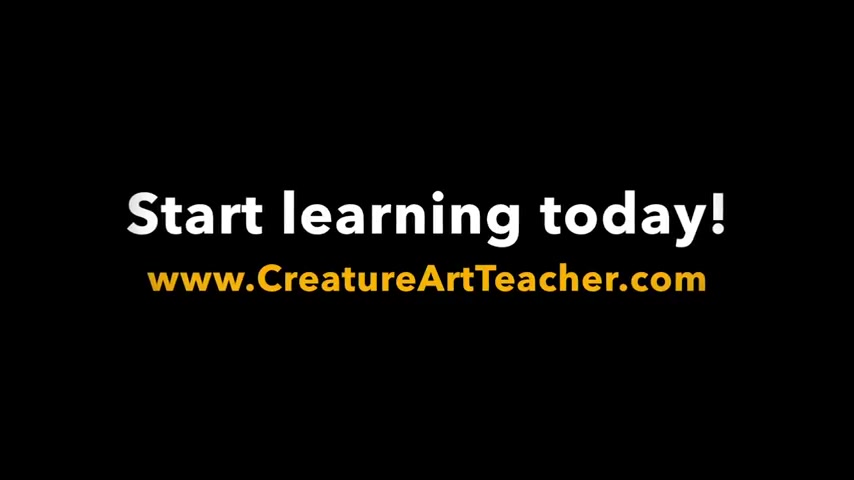
Hey , everybody .
Aaron Blaze here .
And um I want to talk to you guys today about uh the essentials of animal drawing .
I get a lot of questions from people asking me how I got to where I am with my animal drawing .
How do I draw accurate anatomy ?
How do I draw animals out of my head , that sort of thing .
And I thought , you know what it might be kind of fun to put together a video and talk about what I consider the essentials to good animal drawing and more specifically good animal life drawing .
Because if you can get out and you can do uh animal life drawing , that's gonna create images in your head .
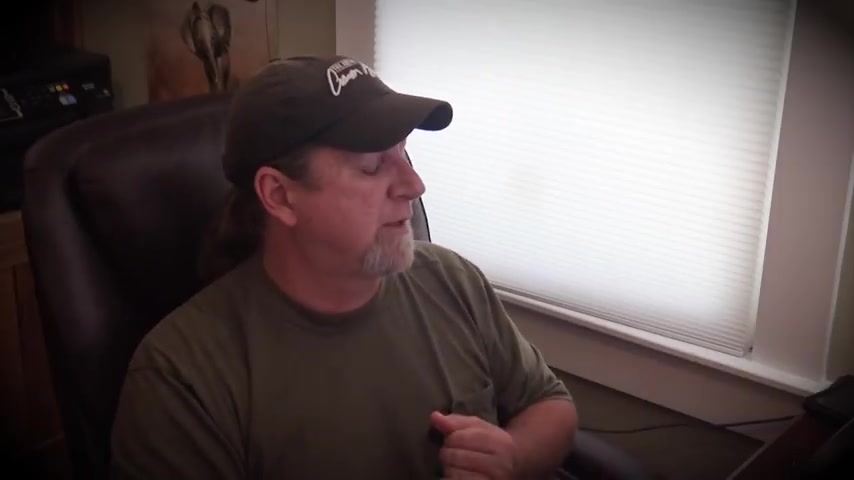
You're gonna be able to build up your , your visual library that I , what I always call it your visual library and you're gonna be able to later go back to your studio and over time with more ease , you're gonna be able to draw animals out of your head , but you have to draw them from life and not just and I don't mean from , you know , from photographs and from video , I mean from life getting out there and struggling with that because it is a struggle when you first do it and drawing from life .
And so I thought , you know what a lot of people struggle with it .
Why don't I tell them what I do what I think about .
And so that's what we're gonna do today .
So the first thing before you even go out more often than not , you know what you're gonna be drawing when you go out , a lot of people are gonna head out to the zoo , they're gonna be heading out into the woods , they're gonna head out to a farm .
You're gonna be drawing your , your dog , your cat , whatever it might be when you're drawing animals from life , know ahead of time what you're gonna be drawing .
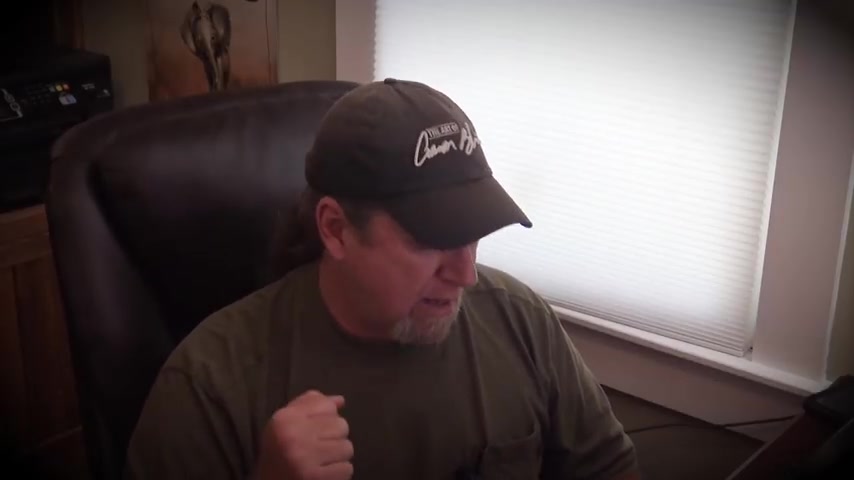
And then if you have the ability , brush up on your anatomy first , a lot of people think by going out and drawing animals from life , you're learning the anatomy and in a sense you are , but it is so much , you'll have an easier time drawing animals from life .
If you understand what's happening underneath the skin first , it's the same with human figure drawing .
If you understand the anatomy first , when you go in to sit down and start figure drawing , you're going to have a little bit easier time because you understand what's happening under that skin .
And so for instance , we're going to be going out today and we're gonna be drawing some farm animals .
There's a farm nearby where I live here and they've got donkeys , they've got goats and chickens and ducks and turkeys and all kinds of fun stuff .
And , um , and I thought , you know what , it may fun to go out and draw there .
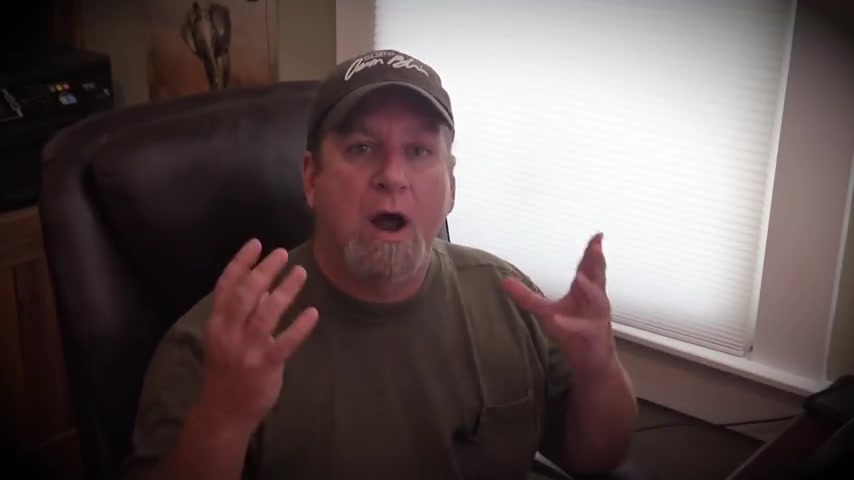
But ahead of time I thought , you know , it's gonna be interesting to pull up some , some , some of those animals and look at their anatomy .
Now , one of the things that I have done , people think that I'm , I'm memorizing all this different anatomy from animal to animal to animal .
And I'm really not .
What I'm doing is I'm memorizing , I memorize the head , I memorize the shoulders , I memorize the trunk , the hips and then , and then going into the tail and legs .
Now I know that covers the whole body .
But I'm basically , I'm memorizing a generic animal because four legged animals , for example , are basically built the same way .
Even though you , you can argue like a horse which is a hoofed animal and a cat which is uh walks on their toes , our five toes and the wrist is located much lower on the front legs .
Even though there's slight differences , there , everything is basically the same .
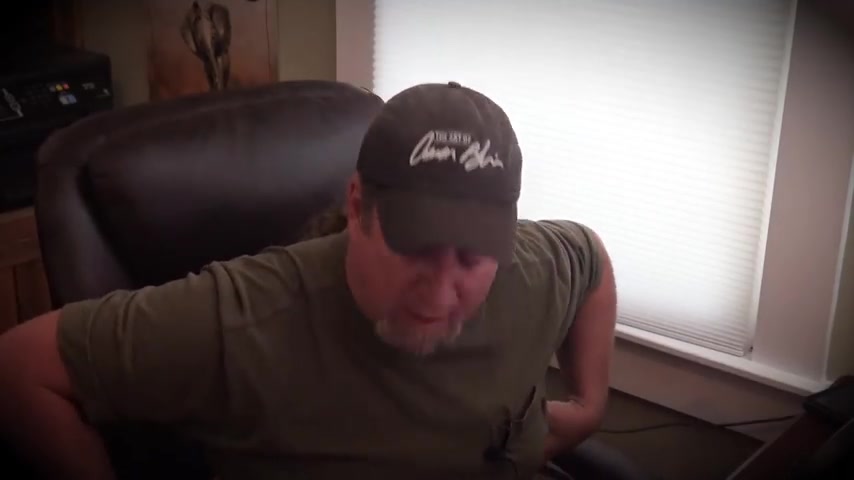
And so the point I'm trying to make is we all basically have the same parts .
We have a head connected to a neck and we have a spinal column that goes down , our spinal column supports our rib cage attached to that rib cage is our scapula , which goes into our upper arms , lower arms and hands , we go into a pelvis , we go into our hips , we go into our femur , lower legs and feet .
We all have those parts , humans , uh , horses , goats , even turkeys .
And I'm gonna show you what I'm talking about .
So why don't we refer back to here real quick ?
I'm gonna throw my glasses on .
And if you look at this donkey , for example , here we've got his head , we've got this nice s flow in the , in the , in the bones of the neck .
But the , the things that I really remember is I think about , OK , because a lot of people get confused on what's happening with the mechanics of the , of the legs .
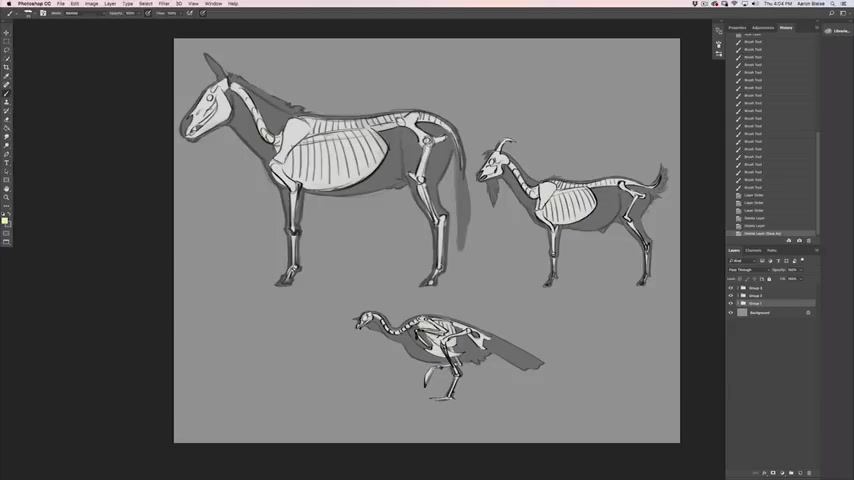
So think about underneath , I think about where that scapula is located , how it goes into the shoulder , into the elbow , down into the wrist .
This is the wrist right here and down into those hooves , come back into a rib cage back here .
And then once again thinking about what's happening with the pelvis and the femur coming in off of the , the right here , the knee , ankle and down into the rest of the foot .
I remember those proportions .
But when you go to a goat , you've got all the same stuff .
So when you're looking at a goat out there , you know , OK , there's a scapula under there right there which goes into his shoulder , which comes back to an elbow which comes down to the wrist and down the rest of the feet .
And the reason I'm talking about these different parts is because when you get out there , those animals are gonna be moving around .
And so you're gonna find a pose that you might like .
And I'm gonna , when we get out there , I'm gonna talk about some of the techniques to find the poses while they're moving around .
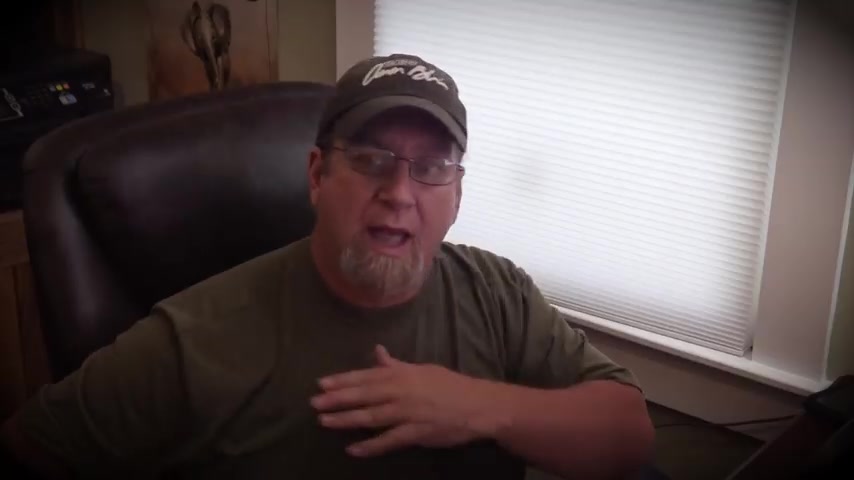
But when you do find a pose and you look back , you're going to see that they're , they're not in the same pose that you started with .
And so you have to remember what's happening underneath that skin in order to draw accurately what's going on .
So if I know what that scapula is connecting to his shoulder , on the goat , for example , and he might be pulled back here , then I understand how that , how those mechanics are going to work .
OK .
And , and one of the other things that I , I'm gonna tell you when we get out there is just to spend a little bit of time watching those animals move around as you watch them , you'll start to see the anatomy working under the skin , you'll see proportions and that sort of thing .
But I want to save that for when we get out there .
But so I've talked about the donkey , I've talked about a goat , but let's go down to a turkey which is completely different seemingly .
Um When you look at their silhouette , you know , it's obviously a completely different animal .
But look , we've got the skull different proportion , but we've got that skull even look at that s shape and the neck .
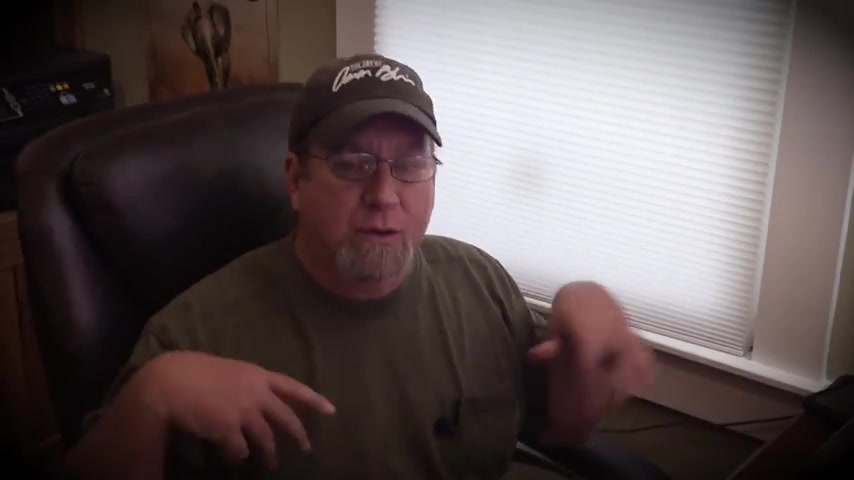
It's very similar to what's happening with the other two animals and it goes into the rib cage .
Now , birds uh have a different adaptation uh with their , their pelvis and their back have fused vertebrae , fused together , things like that , that to stiffen it to support the , the musculature that's needed for flight .
But they , all the parts are still there that pelvis is still there .
The other thing that people get confused about on a bird , you know , look , we've got , that thigh is way up here , thighs , way up here .
That , that femur connects at the middle of the pelvis , just like on the other animals on the back of the pelvis .
It comes up to a knee which is right here , down to an ankle and down into the toes .
It's the exact same thing even on the wings , you get confused .
Some people don't understand what's going on with the wings .
Well , all you have to do is think about your own arm .
If you sit here , you got your shoulder , you got your upper arm .
And if you do this , you've got a bird's wing .
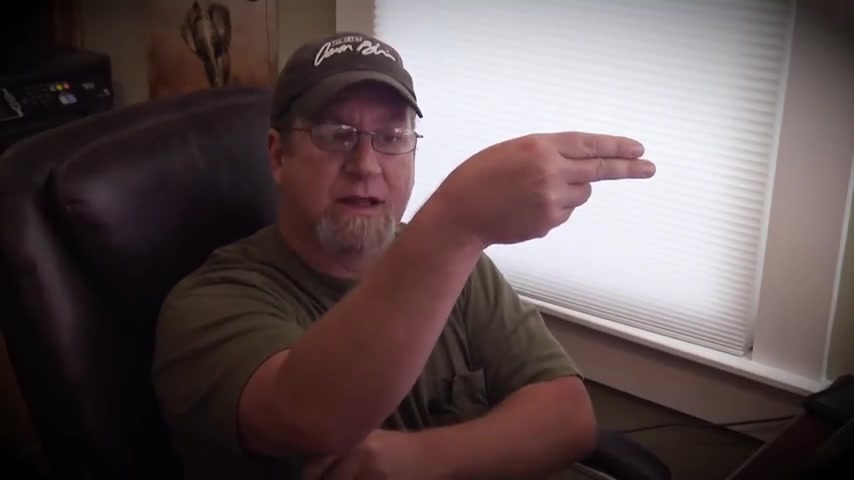
If you fold your arm out like this , that's a bird opening up its swing and all the feathers coming off , they're exactly the same parts it's just that birds have very highly specialized finger bones now where some of them have dissolved .
But now they've got , they've evolved where they have fingers that have come out , the fingers come out and the feathers have come off of those right off the backs of the arms , but they still have an elbow .
They've got the upper arm , the upper arm and lower arm , all of that is still there .
So what I'm saying is understand your comparative anatomy because once you , once you memorize the different parts of the body , the main parts , the scapula , the upper arm , lower arm , hands , rib cages , all those different parts , then you're gonna understand from animal to animal , how they vary and you're gonna see how they're gonna move differently from animal to animal .
So that's the first thing .
So we're gonna be going out and we're gonna be drawing farm animals , like I said , donkeys , goats , turkeys among other things .
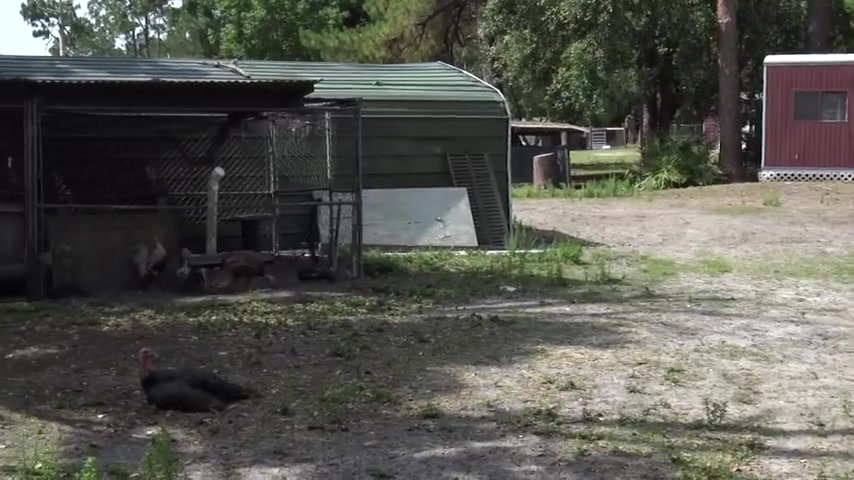
And so I've taken it upon myself to go through .
I've gone into Google , I've looked up different uh uh uh subject matters such as goats and , and donkeys and skeletons , musculature , that sort of thing just to brush up , go through .
And if you're gonna do that , I really recommend going through and doing that ahead of time , then go out , then you've got it fresh in your head , then you can go out and you can draw with a little bit more confidence .
So now that we've done that .
Why don't we head out to the farm and we'll do some drawing on location .
Ok .
So today we're out at my friend Brian Johnson's farm .
Um , you know , sometimes you don't , you don't get to go to the zoo , you don't get to go see , you know , draw big exotic cats and all that sort of thing .
But if you can find a farm that has cows , chickens , goats , like I'm at , you can have just as much fun as a matter of fact , you might even be able to get a little bit closer and uh and have better access and what you would have at the zoo .
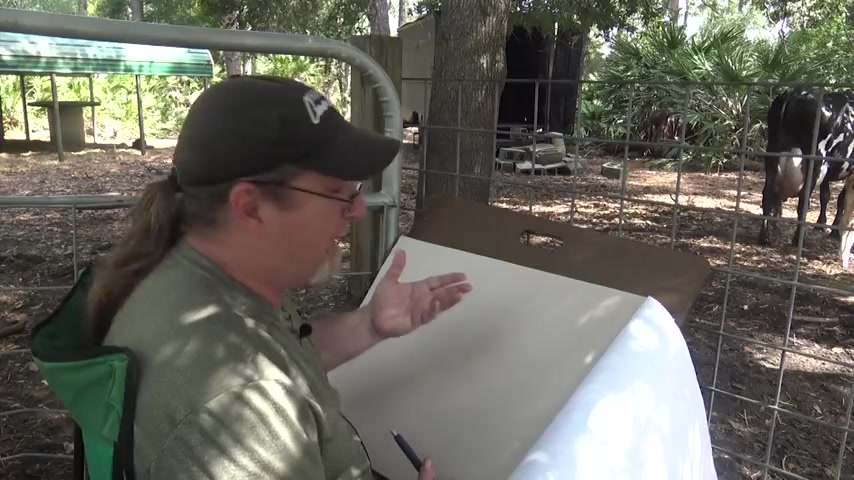
So , uh today I'm here with this cow and she's just had a baby .
They're right here against the fence .
They're beautiful subjects .
And so we're gonna sit and draw .
Now , you know , I , I've already talked about making sure that you've got your anatomy set .
You , you , you've got a basic understanding of that .
The next thing when I come out and I'm actually on location , I don't just sit and start drawing .
The first thing that I do is I'm just gonna sit and I , and I'm gonna look and just sit and look at the forms , what and what I'm doing when I'm doing that is I'm just taking it all in , I'm taking in her shape , her rhythms , her proportions , all of that .
I'm gonna let her walk around and that's , that's part of the , the , the issue .
You know , when you're sitting drawing animals from life , they're gonna walk around , they're gonna move on you .
They're gonna go different places .
And so make sure you just sit there and just look at their form and try to soak it all in .
And we've also got this guy here .
Oh , what's his name ?
Brian ?
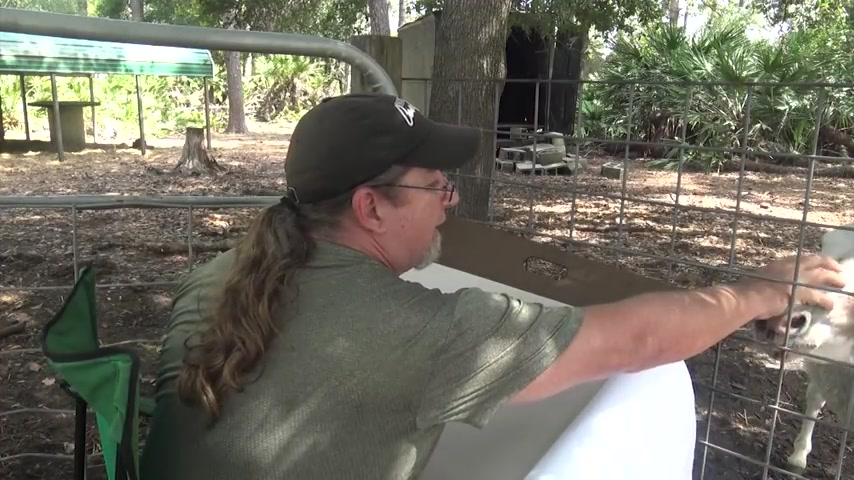
This is Davey .
So , and Davy is very curious .
He's a good guy .
Hi , Davy .
And he's gonna be a good drawing subject today as well .
So , like I said , I like to just sit , look , look at his proportions and just kind of take it all in before I actually start to draw .
You know , once you understand that the general anatomy of animals in general and understanding the pelvis in relation ship to the rib cage in relation to the scapula and upper arm bones and you know , into the neck and into the skull , how all that fits .
There's a certain way that four legged animals work and there's a certain way that we work .
But once again , like I said , we all have the same parts .
They're all just in different proportions .
See , because I already have a basic understanding of horse anatomy .
Obviously , it crosses over into donkey anatomy .
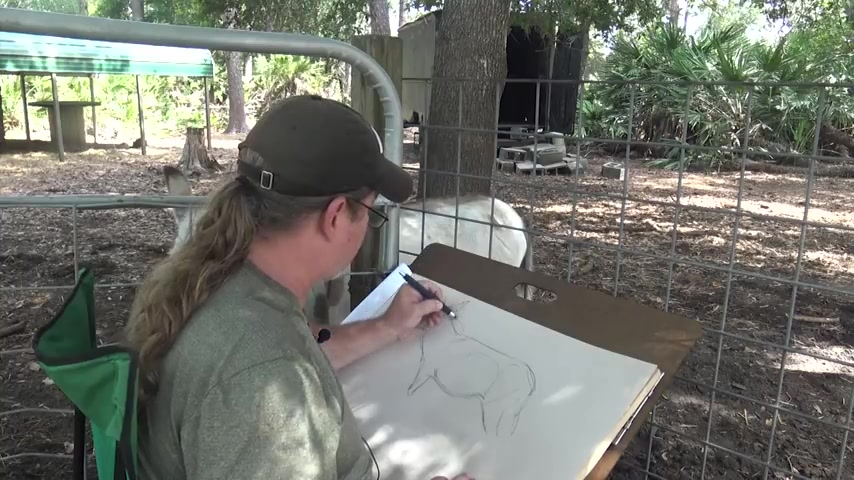
I can sit down and get a sense of the pose that I want to do if he strikes a pose I like .
And then I can sit down and use that anatomy knowledge to finish it all out .
One of the other techniques that I'll use beyond just sitting there and looking and getting a sense of your subject .
The next thing if your subject is moving around , which I I did with this guy is what I'll do is I'll look at the subject and then look away , look at them and then look away , especially if they're moving around .
What that is , what that's gonna do is that it leaves a flash in your brain .
It leaves a quick pose on an , an image of a single image .
And uh and you can sketch that out really fast .
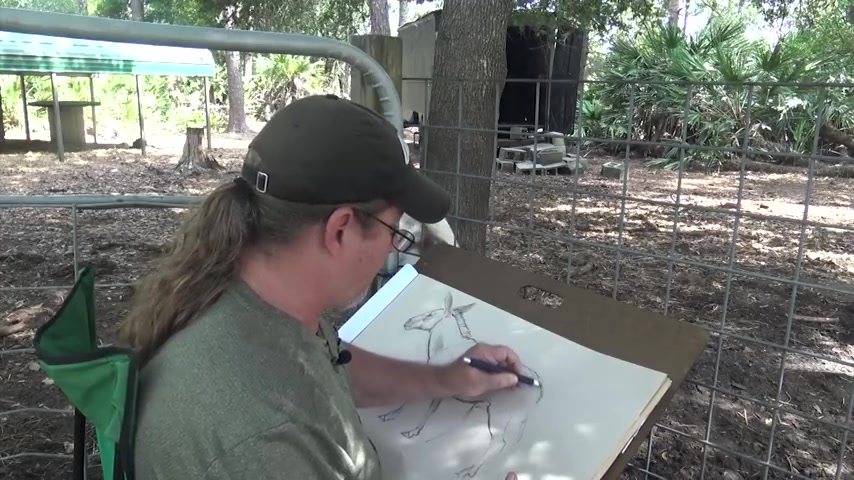
And then if the animal is moving in a repetitious manner , meaning if it's pacing its enclosure , you have the ability to kind of look away at the same time each time and you can get a good sense of what that pose might be .
And then once you've got that roughed in , then you can just refer back to the animal and continue to draw being up close and intimate .
Like this really gives you the ability to create some nice stuff .
I'm really enjoying this .
Just this first sketch that I'm doing .
I'm really enjoying the other thing too is I try to , I like to draw big if I'm going out and drawing on location and I like to draw bold .
I don't want to get in there and get caught up noodling with a little tiny pencil and a little piece of paper for some people .
That's ok .
But for me , I recommend going bigger because you can feel the proportions a little bit better .
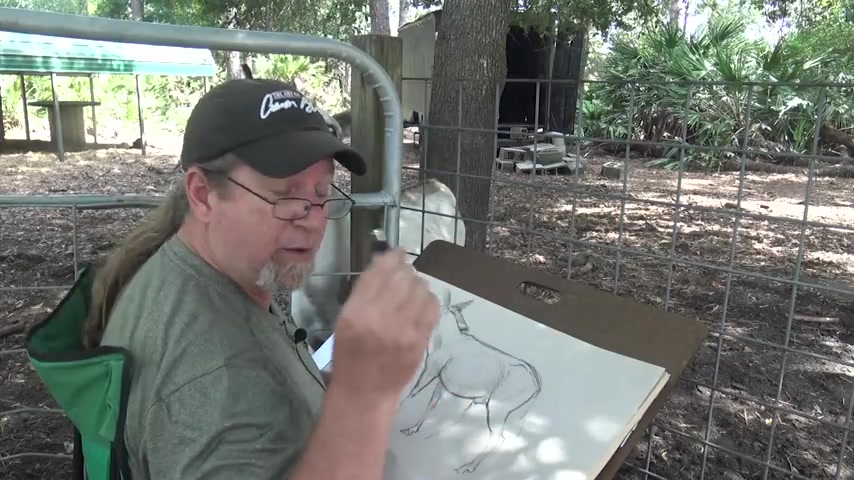
And if you go thick with a thick lead pencil , like I'm using today today , it's actually a , a black pastel piece just stuck into a holder and I leave it dull .
I wanna go real blunt and it forces me to , to go bold and not noodle and , and try to work the small , you know , get too small .
It forces me to , to look at the big shapes like I'm doing here .
Thanks because that's really all it's about when you , you know , when it , what it's all about when you're out drawing on location , you want to , when you're drawing from life .
A lot of times it's not really about getting a great drawing .
You wanna , you just wanna make sure you're observing and getting , getting information , you know , and you , and sometimes you'll struggle , especially if you're new at it .
It's something you're gonna struggle at .
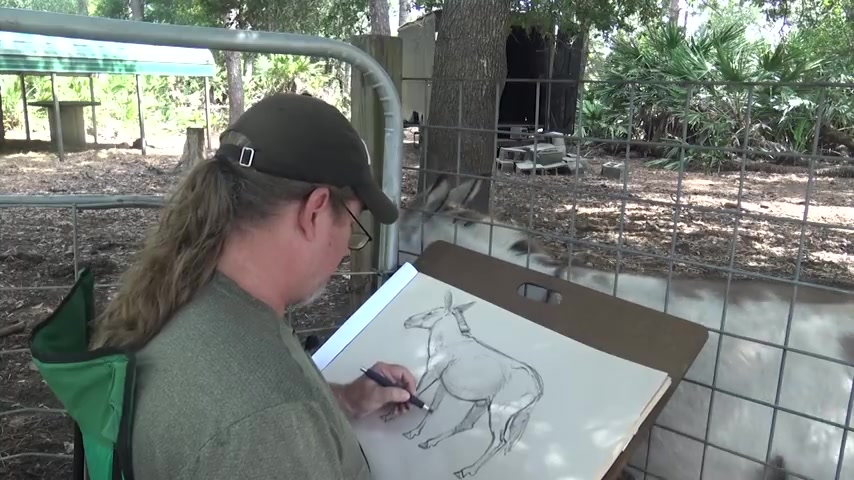
But that's ok .
We've got , it's great .
We've got donkeys out here .
We've got alpacas , we've got horses , we've got goats , we've got rabbits and turkeys and chickens and , you know , that's just as good as any zoo that we could go to .
I really love it .
This guy is a great subject .
It's a beautiful day .
We've got out here .
We're beating the rain .
One thing I'm doing , you know , when in the shaded areas in the shadow areas .
I'm drawing a little more heavy to indicate shadow without having to necessarily draw shadow .
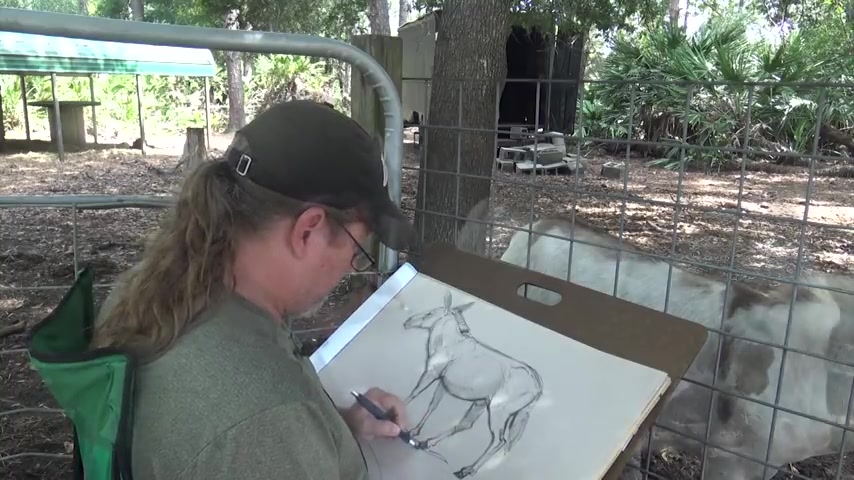
But I'm keeping everything just trying to keep everything loose .
I draw quickly and bold .
I don't , I don't sketch like this .
I try to come in and lay everything down with a bold stroke with a confident stroke and that comes with practice .
That's another thing where , you know , you , you'll struggle with that first and what's nice too , if you can get intimate like this , you can get in and you can work some details in once you get your sketch in , try very hard to keep your proportions consistent .
That's what gives you , that's what's gonna separate a good animal drawing from life from a bad animal drawing .
You want to make sure your proportions are accurate .
So I'm constantly comparing head size to the body size .
This is , this is another method for good animal drawing constantly .
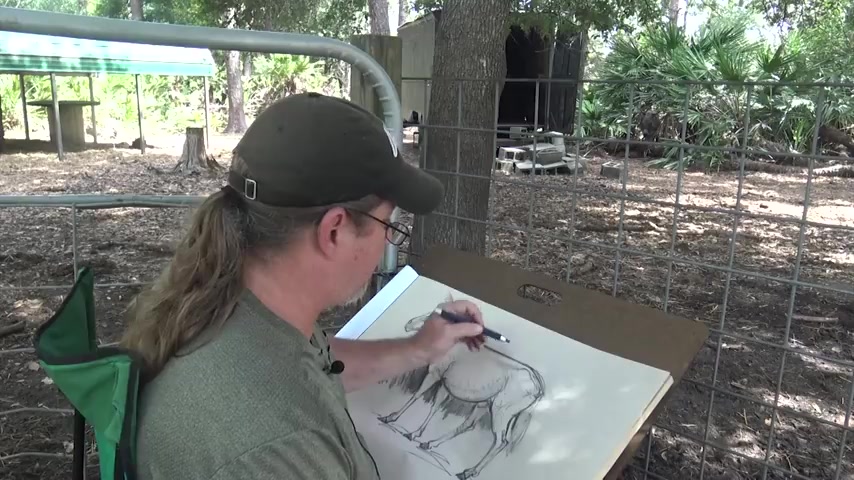
You know , uh you don't have to necessarily measure but just take a mental note of neck length to body length .
Um You know , here I was looking at , you know , is his , is his back line straight or is it curved like a horses ?
And in this case , his back line was more straight .
He's got a bigger gut in proportion to his body than a horse does .
And so therefore , his back is gonna be a little straighter because it's got to support more weight .
It's more like a suspension bridge .
Once again , going back to knowing that anatomy pay particular attention to the Pelvis area .
Pelvis area .
That's an area that a lot of people misunderstand .
Your hip is up here .
The , the can where the femur attaches is actually back here and the knee is right here where the body work connects with the body , keeping those proportions straight is really important .
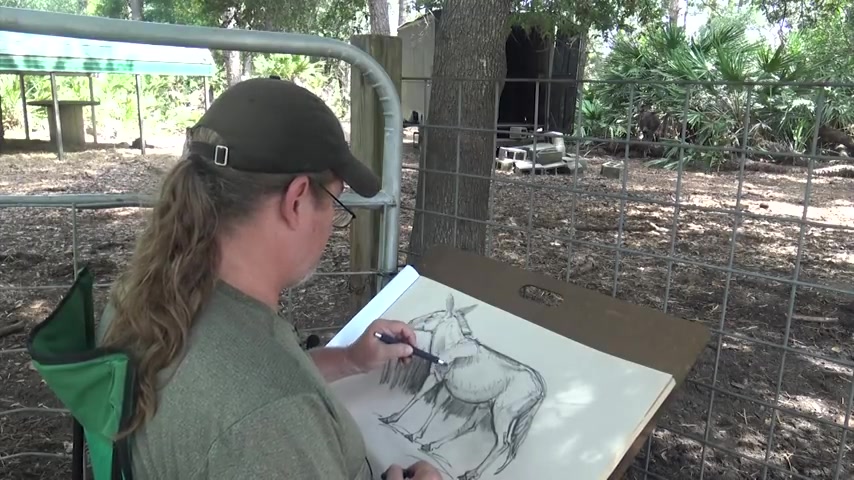
Yeah , getting some last details in .
He's got a few spots on him that I thought I'd , I'd hate Jesus .
He's got tricep muscles just like we do deltoids right here that wrap around into a pectoralis muscle , which is actually wraps around right underneath the body here and he's got a big fat belly , which if you could see underneath , he's got la muscle that comes this way along with the crates muscles that wrap over the ribs , ribs .
The great thing about working on a drawing at a farm is you , you're gonna have different subjects coming and going .
So Davey had just finished up drawing with Davey and he's over there relieving himself .
So we got a new guy that's come up and he wants to see what's going on .
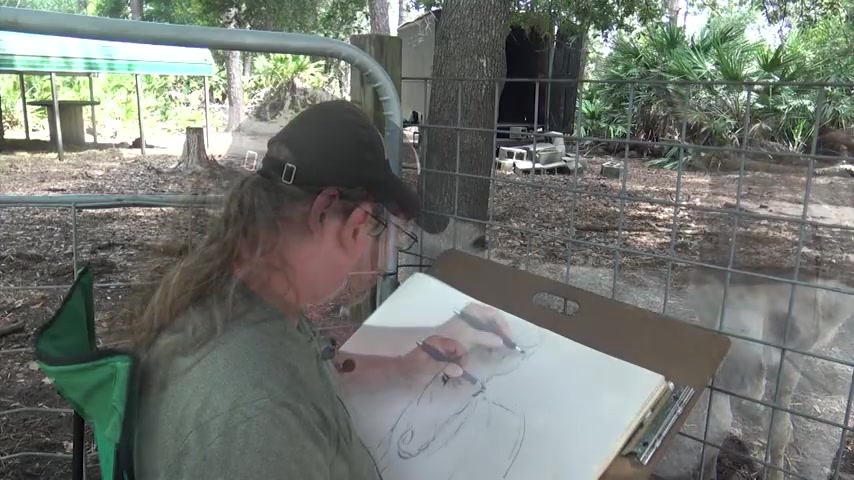
So I think I'm just gonna draw him sitting right in front of me .
So once again , here , I'm drawing really quickly , I'm drawing another pose that only lasted for a split second and then he was gone .
So now I've got to kind of rely on some of my horse anatomy knowledge to fill in the blanks .
Hey , hey , you .
Ok .
Yeah , I'm thinking about that .
They have a cheekbone that comes back right along here .
The ID for the eye socket , right in here .
There's a hollow where the nasal bone opens right up in here .
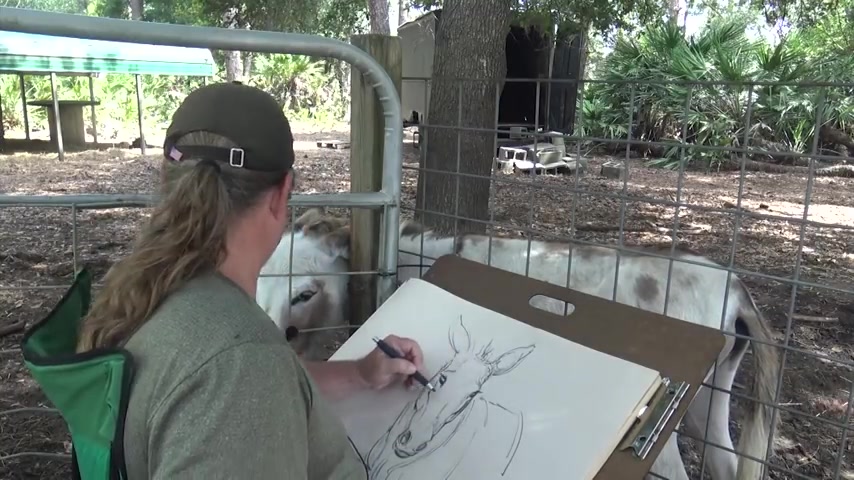
If we were to look through , you're chewing on my , you chewing on my chair .
Nice and remember it's not always about making a beautiful drawing because Lord knows I don't make beautiful drawings all the time .
Very rarely do I get a good one out .
But it's really about making the observations and seeing , seeing things that you never would have .
You know , it's hard to sit and imagine the anatomy even if you know the anatomy .
So this is such great practice to sit down and this draw from life .
You know , I've been doing this for 40 years and I still need to do this as often as possible to keep my , to get my brain fresh .
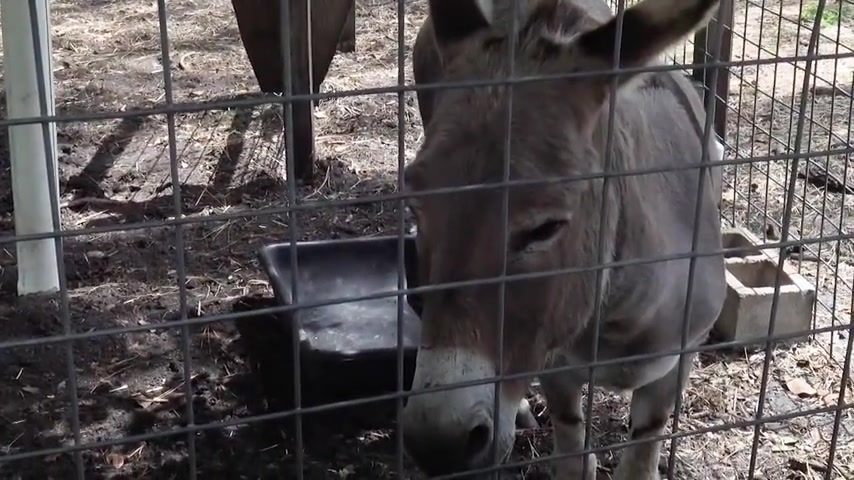
Here we go .
Oh , I love that .
I sometimes if you can get in , you know , intimate like I am now , you can get details that you normally wouldn't get .
I Yeah .
So here I get a chance to really kind of see the detail of this guy's eye and sketch it in .
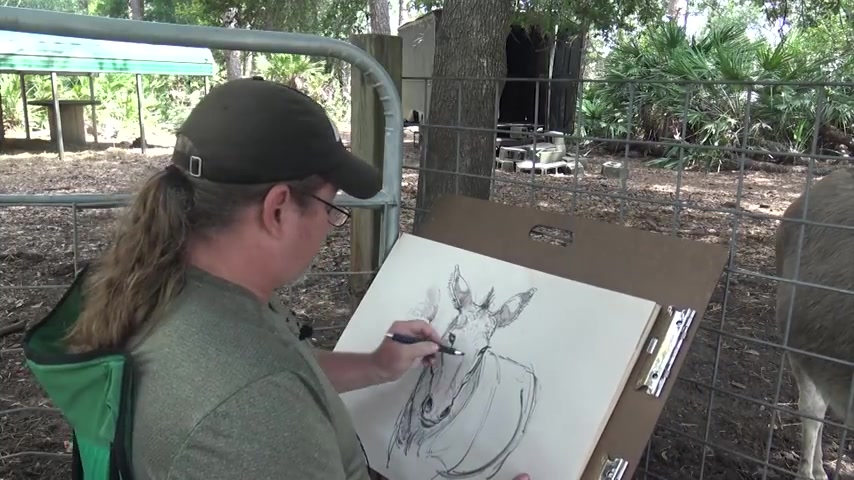
It's really great to be able to get up and close like this .
With these guys .
We have to draw some goats here pretty soon .
Hm .
Another thing to remember for good animal drawing is not every drawing has to be a complete finished rendered beauty .
Here I started , you know , I had the donkey sitting in front of me and I started with his head .
I don't , you know , I'm , I'm not coming down and finishing out the entire thing .
I'm looking at points of interest .
I want to make sure that I'm getting anatomy correct .
So I'm looking at some marys down here in the lower legs .
But beyond that , I'm just drawing very quickly and hitting some areas that I find interesting like in the face .
And I chose to add some detail in here and I'm just going to let it go from there and that's a perfectly viable drawing .
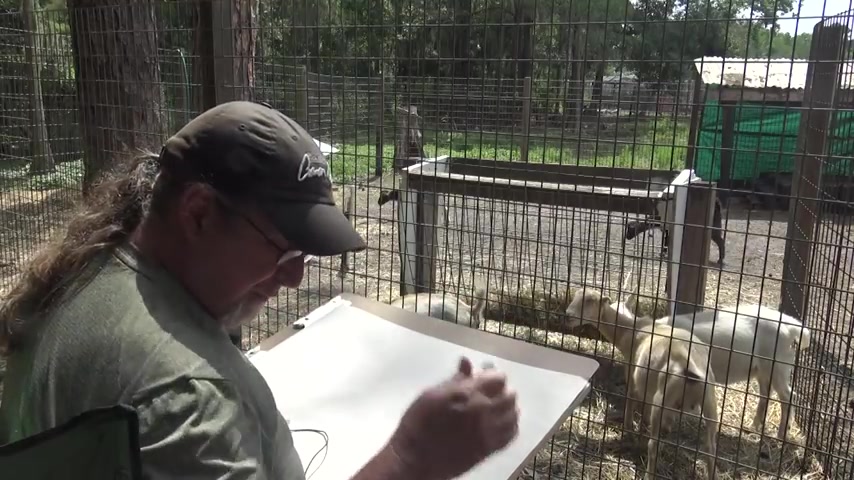
So one of the other things I forgot to mention earlier , that's really important when you come out to do animal drawing , um bring all of the equipment that you're gonna need .
I always bring a chair to sit in a nice board to draw on , especially if I'm drawing big like this chair , bring a chair that's most important .
If you can carry it , you know , at your local drug store or whatever , you can get these chairs and you can just throw it in the sling , throw it over your shoulder and you will be so glad you did because it will save your back and you can just sit for hours and draw .
I keep a nice big clipboard like this for my big pads and then , you know , having the right erasers pencils , all of that .
But most important , make sure you have that chair notice on this one how I'm staying very , very loose .
Sometimes I like to just go very loose , very lightly to get everything in first be .
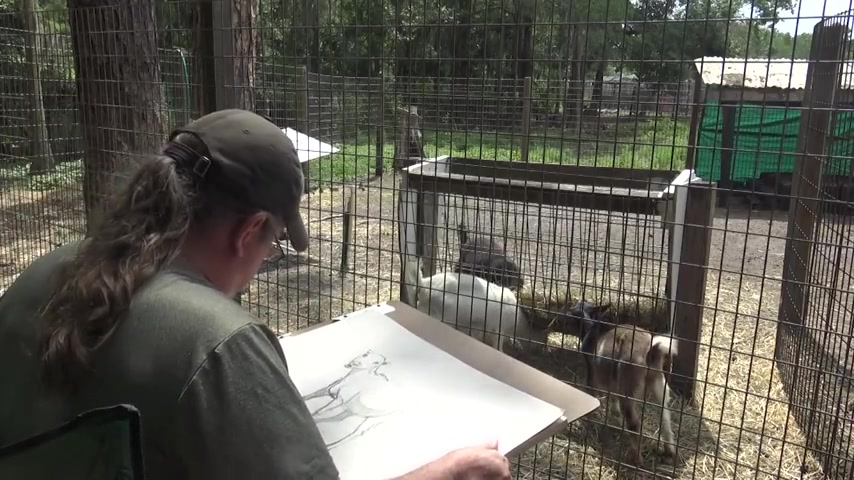
Here's something else .
If you're sensitive to the sun , this is another one .
A lot of people forget and you're sitting in the sunlight like I am , bring sunscreen .
If you're sensitive , you'll end up getting really sunburn and sunglasses .
I , you know , right now I'm not wearing them because we were , uh , we were sitting in , uh , we were sitting in the shade but make sure you have a good set of sunglasses because that paper can get really bright as well .
So here you can see , I started out with something that was fairly loose , but then I slowly went in and refined it , thinking about anatomy , thinking about what's going on underneath all of that skin and fur .
And that's probably the , the , the , the strongest thing that you can do for yourself .
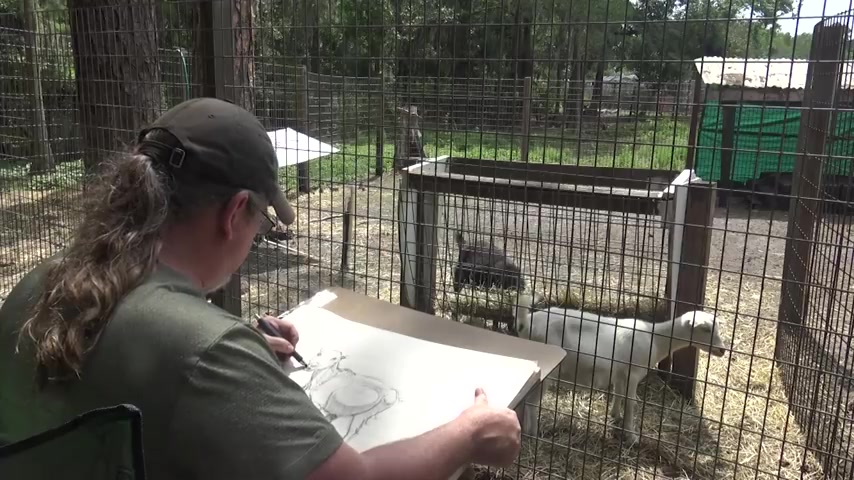
The most important thing you can do for yourself is to really study that anatomy before you go out and draw a lot of people think .
Well , I'm going out , you know , I'm going out to study the anatomy and that does help .
But if you have a good understanding of what's going on before you actually go out , it's really gonna help you with your accuracy uh in your drawing .
And even if it's as simple as you know , once you , if you know what you're gonna go out to draw ahead of time , go ahead and Google some , some anatomy images of what those animals look like underneath the ske like goat skeletons .
For instance , if you're going to a farm like me , look up a goat skeleton , look up a donkey skeleton , look up the musculature , you know , have a quick study of it before you go out and it'll help you with your drawing .
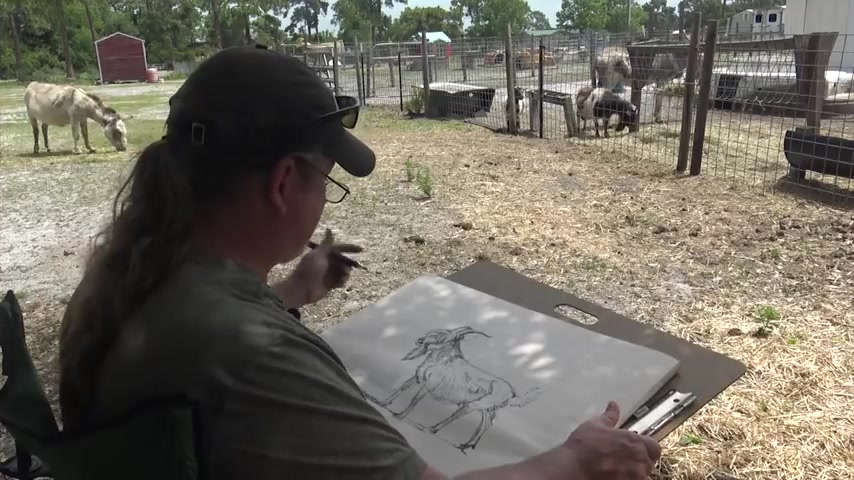
So in review , remember you don't have to be in the wilds of Africa or in some big zoo somewhere .
You can just be on a farm , you can be in your own house , drawing your pet .
Um You don't need big exotic animals .
And remember before you go out , understand your anatomy , understand the basics of the anatomy and it will make everything so much easier .
Once you get out into the field and you start drawing next .
When you actually sit down , remember you don't have to start drawing right away .
You can just sit there and relax and soak it in .
Look at the rhythms , look at the the proportions , all of that , look at the flow .
After that .
When you want to find a pose , try looking at the animal and then looking away , looking at the animal , then looking away and when you look away , you'll have that flash of a pose .
Remember , stay loose .
You don't want to draw really tight .
If you can draw large , it'll keep you loose .
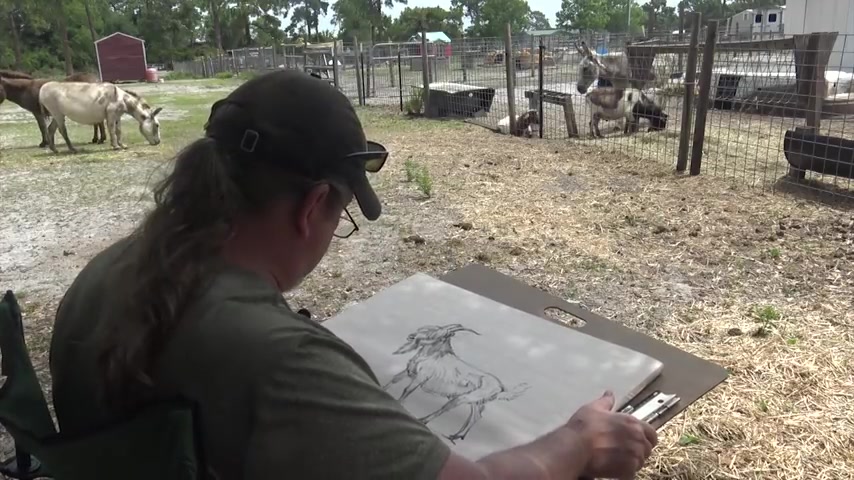
And I try to keep , once again , I try to keep a nice big fat uh drawing utensil so that I'm , I'm forced to draw bold .
The other thing too , be prepared when you go out , bring your sunscreen , bring chairs , bring everything that's gonna make your drawing experience more comfortable so that you can sit there and not be in pain and you can focus really on the drawing as you sit there .
Remember , you don't have to have big render drawings .
Also , you can find little intimate uh examples .
Remember I was drawing the eyeball of that donkey that I found interesting .
It's all about having fun .
Remember , it's not about getting great drawings .
It's , it's about gathering information as you sit there and you look at the animal , you're gathering information , you're , you're , you're picking up things that you're gonna be able to refer to later on and pull from your mind .
It's about filling up that visual library that I'm always talking about .
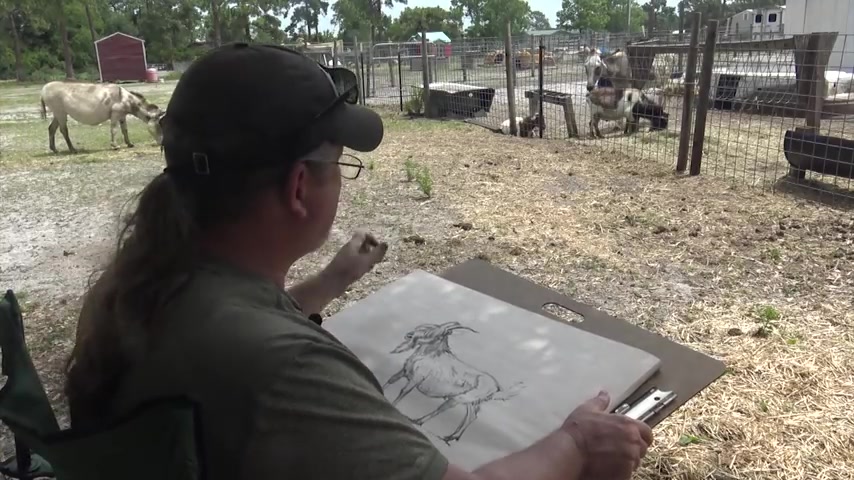
So go out there and have some fun , find some animal animals to draw , know your anatomy before going out .
Get out there , relax and have some fun .
Enjoy it .
Until next time .
I'll talk to you later .
Bye .
Are you looking for a way to reach a wider audience and get more views on your videos?
Our innovative video to text transcribing service can help you do just that.
We provide accurate transcriptions of your videos along with visual content that will help you attract new viewers and keep them engaged. Plus, our data analytics and ad campaign tools can help you monetize your content and maximize your revenue.
Let's partner up and take your video content to the next level!
Contact us today to learn more.